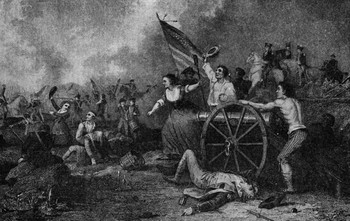She was born Mary Ludwig Hays McCauly on October 13, 1754, in Trenton, N.J. She was the child of German immigrants who grew up working as a servant girl in Carlisle, Penn. When she was 16, she married John Casper Hays, a barber who joined the Continental Army. She became Molly Pitcher when she carried pitchers of water to the American soldiers as they fought the British during the Revolutionary War. Helping care for and feed her husband and many other soldiers, "Molly" saw firsthand how dangerous war really was. During one intense battle, she carried a wounded American soldier from the field on her back. She was also at Valley Forge for the cold, cold winter, which shrunk the American Army considerably. At the Battle of Monmouth, on June 28, 1778, John Hays collapsed from the heat. He wasn't the only one. It was very hot that day, especially in the thick of battle, with gunfire and cannon fire ripping through the sky under a hot sun. Molly was devastated. Her husband was unconscious. Her husband's job in the army was to load cannons so they could be fired at the enemy. In the heat of battle, Molly took over for her husband and filled cannons herself! In the face of heavy enemy fire, Molly stood her ground and pounded away at the cannons, helping the Americans stay on the battlefield and eventually win the battle.
She earned the respect of the men on the battlefield and of General George Washington, who made it possible for her to be called "Sergeant Molly." |
|
Social Studies for Kids
copyright 2002–2025
David White





